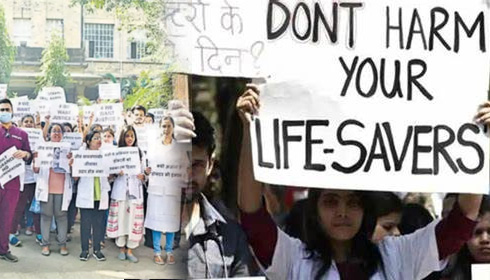
Global Crisis: Violence Against Healthcare Workers on the Rise, Reveals University of Queensland Study
The University of Queensland's pioneering study reveals a global increase in the frequency and intensity of violence against healthcare workers, which poses serious dangers to health systems and patient care. The comprehensive study, conducted by UQ Medicine alumnus Dr. Conor O'Brien, reviewed more than 3,000 research papers from 2016 to 2023, uncovering alarming patterns and crucial insights into this enduring problem.
Escalating Violence: A Grim Reality
Dr. O'Brien's research clearly shows the dangers that healthcare professionals confront, particularly those working night shifts in emergency rooms and younger, less experienced employees. "Some incidents resulted in fatalities, with more than 370 healthcare workers killed in the past seven years, including 161 medics in conflict zones," Dr O'Brien remarked, emphasizing the serious repercussions of this violence.
According to the study, female healthcare workers are more likely to encounter non-physical violence and sexual harassment than their male counterparts. According to Dr O'Brien, "Acts of violence included verbal threats or intimidation, and those most at risk were in emergency departments, those on nightshifts, and younger, less experienced staff."
Australia's Response: Policy and Challenges
Australia stands out as a country that has introduced various policies and legislative measures to combat workplace violence over the last two decades. These steps include the creation of new criminal penalties for perpetrators and legislative requirements for management to protect employees. However, Dr O'Brien noted that despite their importance, these steps have not decreased violent incidents, highlighting the issue's complexity.
Contributing Factors: A Complex Web
Professor Andre van Zundert of UQ's Faculty of Medicine identified numerous contributing variables to the increase in violence against healthcare professionals. "A shortage of staff or resources, long wait times, poor communication, and insufficient security and organizational support all play a role," he told me. Furthermore, growing patient expectations of healthcare systems, combined with tensions worsened by the COVID-19 epidemic, have strained the connection between the general public and healthcare staff.
A comprehensive assessment framework
The researchers suggest a paradigm for assessing the risk of workplace violence that takes into account both internal and external elements, such as staff, patients, facilities, and socio-cultural impacts. The majority of the analyzed studies used surveys and self-reporting to assess outcomes, indicating a significant variety in methodology and populations. Despite these variances, we discovered broad patterns in aetiology, risk factors, incidence, and prevalence.
The study also developed a working definition of workplace violence (WPV) based on common characteristics in the literature. WPV includes a wide range of actions, such as verbal threats or intimidation, physical assault, and improper emotional or sexual activity. These activities can be intentional, committed by those with cognitive capacity, or the outcome of pathological processes or drunkenness in those who lack capacity. Regardless of their origin, such activities have had, or are likely to have, a negative impact on healthcare professionals' safety and physical, mental, or emotional well-being. Importantly, these violent acts occur when healthcare personnel are performing their tasks or when the victim is identified as a healthcare worker. This comprehensive definition encompasses the wide range of behaviours and impacts investigated in the literature, offering a nuanced understanding of WPV and its major implications for medical professionals' health and safety.
These features show the range and complexity of the behaviours and impacts examined, providing a more comprehensive view of WPV.
Quality Assessment and Identifying Causation
The study acknowledges that determining causation is difficult due to the nature of workplace violence and the methodology used in the research. The evaluation sought to identify trends and themes across many healthcare contexts, giving organizations and academics a framework for assessing and investigating their specific WPV challenges.
The University of Queensland-led study finds three major dimensions that typically appear when studying the determinants of workplace violence (WPV) against healthcare workers. The first component, Patient/Visitor Factors, highlights how patients or visitors frequently cause events due to frustration, fear, or mental health difficulties. These emotional causes can lead to aggressive behavior toward healthcare workers.
The second factor, Healthcare Worker Factors, demonstrates that younger, less experienced employees, particularly those working in high-stress environments such as emergency departments, are more vulnerable to violence. Their vulnerability stems from a lack of expertise and the intensive milieu of emergency care.
The third dimension, organizational/social-Cultural factors, identifies systemic concerns such as inadequate personnel, excessive wait times, and poor communication as major factors in WPV. When healthcare institutions are understaffed and overloaded, tensions grow, creating an environment conducive to violence. Additionally, socio-cultural issues, such as public perceptions about healthcare personnel, compound the problem. Negative attitudes and high expectations of healthcare services might result in contentious situations.
By connecting these elements, the study provides a comprehensive framework for understanding the multidimensional nature of WPV. Addressing this issue involves a comprehensive approach that takes into account the emotional states of patients and visitors, the vulnerability of younger personnel, and the systemic challenges that healthcare organizations face. Improving staffing levels, reducing wait times, improving communication, and creating a pleasant socio-cultural environment are all critical measures toward preventing violence against healthcare professionals.
Implications and the way forward
The study emphasizes the urgent need for comprehensive initiatives to reduce violence against healthcare workers. It proposes stronger security measures, improved communication and support systems, as well as additional staffing and resources. Furthermore, addressing the socio-cultural attitudes and expectations of healthcare providers is critical for minimizing violence.
In conclusion, the University of Queensland-led study shows a global epidemic of growing violence against healthcare workers, emphasizing the need for immediate and diverse measures. As Dr. O'Brien put it, "This review provides critical insights into the extent and complexity of workplace violence, underscoring the need for robust and holistic approaches to protect our healthcare workforce."